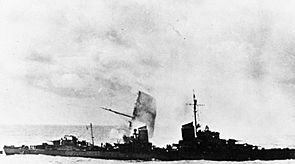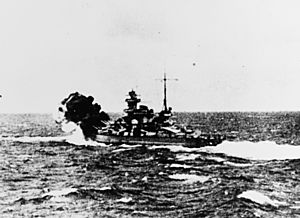Operation Juno facts for kids
Quick facts for kids Operation Juno |
|||||||
|---|---|---|---|---|---|---|---|
| Part of Norwegian Campaign of World War II | |||||||
 Hans Lody rescuing survivors from the troop transport Orama |
|||||||
|
|||||||
| Belligerents | |||||||
| Commanders and leaders | |||||||
| Wilhelm Marschall | Guy D'Oyly-Hughes † | ||||||
| Strength | |||||||
| 2 battleships 1 heavy cruiser 4 destroyers |
1 aircraft carrier 2 destroyers 1 minesweeper 1 troopship 1 oil tanker 1 hospital ship |
||||||
| Casualties and losses | |||||||
| 50 killed 1 battleship damaged |
1,612 killed 1 aircraft carrier sunk 2 destroyers sunk 1 minesweeper sunk 1 troopship sunk 1 oil tanker sunk |
||||||
Operation Juno was a naval mission carried out by Germany during World War II. It took place in the Norwegian Sea in June 1940. The main goal was to attack Allied ships and help German troops fighting in Narvik, Norway.
The most important part of Operation Juno was when two powerful German battleships, the Scharnhorst and the Gneisenau, sank a British aircraft carrier called HMS Glorious. They also sank two British destroyers that were protecting the carrier. Many other Allied ships were sunk during this operation.
The German fleet for Operation Juno included the battleships Scharnhorst and Gneisenau. It also had the heavy cruiser Admiral Hipper and four destroyers: Z20 Karl Galster, Z10 Hans Lody, Z15 Erich Steinbrinck, and Z7 Hermann Schoemann.
The operation started on June 8, 1940. The German ships were supposed to attack the city of Harstad in Norway. This attack was meant to help German soldiers who were fighting in Narvik.
After getting more fuel near Jan Mayen island, the mission changed. The Allied forces were already leaving Norway. So, the German commander, Admiral Wilhelm Marschall, decided to find and sink Allied transport ships instead.
During this time, the Germans sank a troop transport ship called Orama. They also sank the oil tanker Oil Pioneer and a mine-sweeping trawler named HMT Juniper. After these attacks, Admiral Marschall sent the Admiral Hipper and the destroyers to Trondheim. They arrived there on the morning of June 9. The next day, the Admiral Hipper tried to leave Trondheim but a British submarine was spotted, stopping it from leaving.
The Sinking of HMS Glorious
On the night of June 7-8, the British aircraft carrier HMS Glorious took on board several Royal Air Force (RAF) planes. These included ten Gloster Gladiators and eight Hawker Hurricanes. These fighter planes had flown from land bases to avoid being destroyed during the evacuation from Norway. This was the first time modern aircraft without special landing hooks landed on a carrier.
The Glorious was part of a group of ships heading towards Scapa Flow in Scotland. Another aircraft carrier, HMS Ark Royal, was also in this group. Early on June 8, the Glorious asked for permission to sail ahead faster with its two escorting destroyers, HMS Acasta and Ardent.
Some reports suggest that the Glorious was not fully ready for battle. For example, the look-out position high up on the ship was not manned. This meant that the destroyers, which were lower in the water, had to do most of the looking out. Also, not all of the ship's boilers were working. This meant it could not reach its fastest speed as quickly as needed.
The captain of the Glorious, Guy D'Oyly-Hughes, did not send any aircraft into the sky to patrol around the ship. This was reportedly to let the aircrews rest. If planes had been in the air, they might have spotted the German ships sooner. This would have given the Glorious a chance to escape or prepare for a fight. No aircraft were even on the deck ready for a quick launch.
While sailing through the Norwegian Sea on June 8, the Glorious and its two destroyers were spotted by the German battleships Scharnhorst and Gneisenau. This happened at about 69°N 00°E / 69°N 0°E, off the coast of Norway.
The battle lasted about two hours. The carrier and its escort ships were sunk about 170 nmi (310 km; 200 mi) west of Harstad. A total of 1,519 men were killed. Only 45 people survived. A Norwegian merchant ship, the Borgund, rescued one survivor from the Acasta and 38 men from a lifeboat from the Glorious. All 39 survivors were taken to Tórshavn in the Faroe Islands on June 14.
The Scharnhorst hit the Glorious with its first shots at 4:32 PM. This happened before the Glorious's torpedo planes could be launched. The Scharnhorsts second hit, at 4:38 PM, struck the Glorious from a very long distance of 26,300 yd (24,000 m). This was one of the longest-range hits ever recorded. The Gneisenau also hit the Gloriouss bridge.
The British destroyers, Ardent and Acasta, tried to protect the Glorious by making smoke screens. They also kept trying to fire torpedoes at the German ships. At about 5:39 PM, the Scharnhorst was hit by one of four torpedoes launched by the Acasta. Fifty German sailors were killed, and the Scharnhorst took on a lot of water. Its back gun turret was also put out of action.
The Ardent was sunk around 5:20 PM after making seven torpedo attacks. The Glorious sent its last message from about 69°0′N 04°0′E / 69.000°N 4.000°E. Admiral Marschall, who was on the Gneisenau, ordered the Scharnhorst to stop firing at the Glorious. The Gneisenau was closer to the Glorious than the Scharnhorst.
Aftermath of the Battle
After the battle, the Scharnhorst and Gneisenau went to Trondheim for repairs. Because of their dangerous position, they could not stop to rescue any survivors from the sunken British ships.
On June 13, 15 Fleet Air Arm Blackburn Skua bombers from the Ark Royal attacked the Scharnhorst in the harbor. One bomb hit the Scharnhorst, but eight Skua planes were lost. The Skua plane was later removed from operations in 1941.
The sinking of the Glorious, Acasta, and Ardent resulted in the deaths of 1,519 men. This was one of the biggest losses for the British Navy during the war. Two RAF fighter squadrons were also lost. The damage from the torpedo attack forced the Scharnhorst to return to Trondheim for emergency repairs. It then went to Kiel, Germany, on June 23 for more extensive repairs. It stayed there for most of 1940.
Even though the loss of the Glorious was a big blow, the fact that the two powerful German battleships had to return for repairs helped the Allies. It meant that other Allied convoys could reach Britain with much less danger.
See also
- List of Kriegsmarine ships
- List of classes of British ships of World War II


